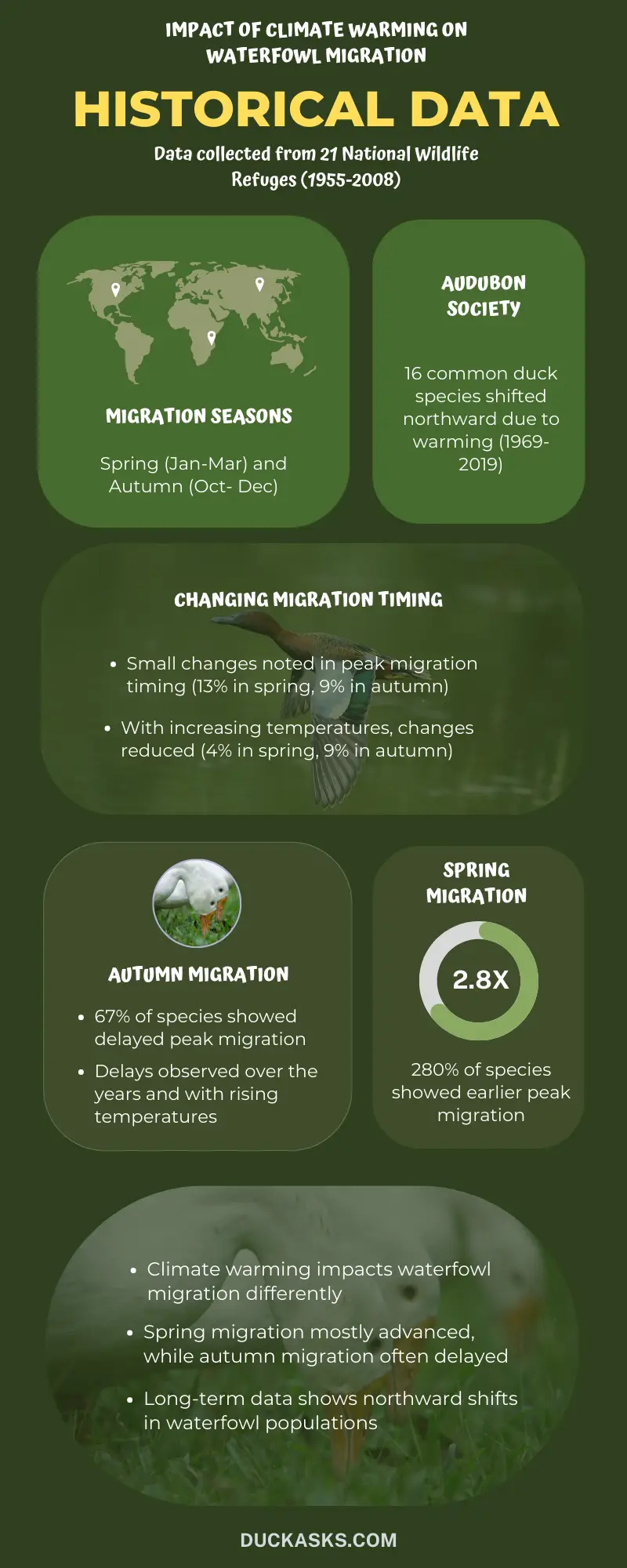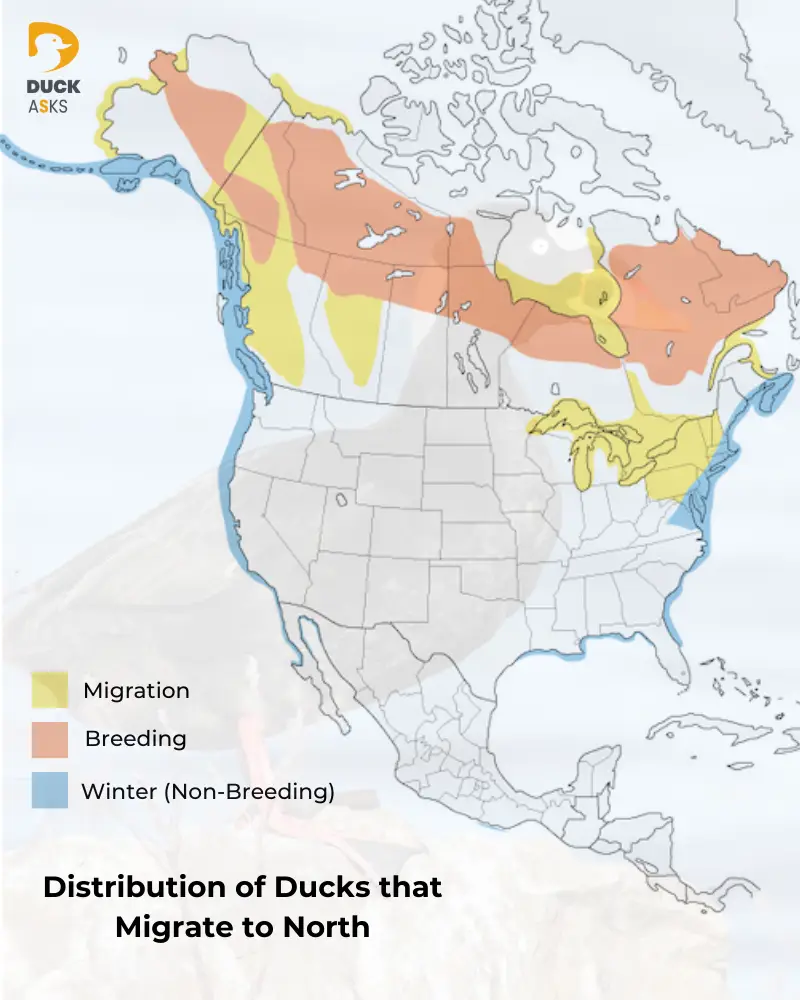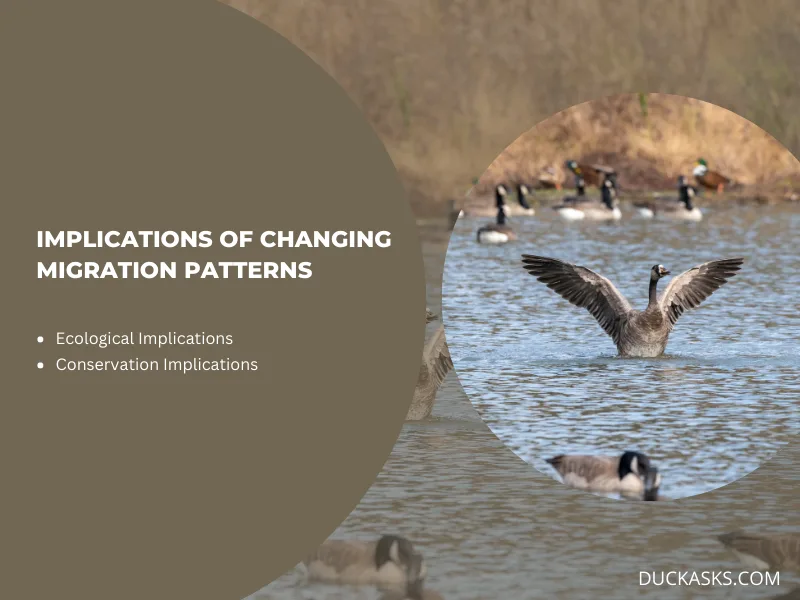Ducks Migration Patterns: Ducks Are Migrating Late
Ducks are migratory birds and are well known for this behavior. They go for both short and long-distance migrations to find abundant food sources, suitable breeding grounds and escape from harsh weather, hunters and predators.
However, recent observations from watchers and ornithologists across North America have highlighted delays in waterfowl autumn migration, which raised concerns about the implications of these shifts.
According to a recent observation and aerial surveys conducted between 1968 and 2011, researchers analyzed the abundance of dabbling ducks during autumn migration. Analysis revealed delays of 11-18 days in migration timing for 4 out of 6 species studied: Mallard, American black duck, American wigeon, and gadwall.
Not only that, there are several other reports and studies claiming some changes in migration patterns and behavior of waterfowl. Let’s explore it further to identify the major changes and what is causing them.
Usual Migration Behavior in Ducks: Why It Is Important?
As mentioned, ducks migrate in response to the declining open water and food availability and to find better food sources or breeding grounds. Migration is adaptive, and its strategy leans on finding food, water, and suitable grounds for breeding.

So, less food and an unfavorable environment mean a faster transition and the departure of ducks. The primary reason for duck migration is survival. They begin to migrate in the fall as the fall weather affects habitat conditions and food availability. When the seasons change, and when it’s warm again, they follow a northern migration and migrate back to their breeding homes.
Usually, ducks migrate from August through September. And the distance covered by migrating ducks can vary widely, with some ducks traveling only a few hundred miles and others crossing entire continents.
Research and Data Analysis on Changing Migration Patterns in Ducks
There are several studies and surveys have been conducted so far to understand the changing migration behavior in waterfowl. Among them, let’s discuss some.
Well, the study we mentioned earlier shows a clear result on this topic; although minor change, it is happening. This was conducted on the most common 6 duck species in the lower Great Lakes region of Ontario from 1968 to 2011.

During this study, researchers analyzed data from the Great Lakes Migrant Waterfowl Survey (GLMWS), which involved visual observation in various survey sectors.
The findings indicated that over the 43-year study period, peak migration for these species occurred 11 to 18 days later, equivalent to a rate of 3 to 5 days per decade. And the delays in migration timing were likely influenced by various factors, including changes in climate and habitat conditions.
From observation, they have also concluded that, as years progressed, the peak migration occurred later, suggesting a trend toward delayed migration.
Another study was conducted on ” changes in waterfowl migration phenologies in central North America, USA.” Here, the researchers investigate changes in the timing of migration among waterfowl species.
For this, they have used historical data collected from 21 National Wildlife Refuges between 1955 and 2008. They examined the timing of migration peak time for different waterfowl species during the spring (January to March) and autumn (October to December).

The study found a small part (13% for spring and 9% for autumn) showing notable changes in the timing of peak migration across the years. But when considering increasing temperatures, the percentages were 4% for spring and 9% for autumn.
And during spring migration, the majority (≥80%) showed advancements in the timing of peak migration. On the other hand, significant changes in autumn peak timing mostly showed delays (67%) both across the years and with increasing temperatures.
The third study supporting today’s topic- was conducted by the National Audubon Society and Clemson University’s James C. Kennedy Waterfowl and Wetlands Conservation Center.
It revealed that 16 common duck species that winter in the Southeastern U.S. have shifted their populations northward over the past 50 years due to climate warming. This study analyzed data collected from 1969 to 2019.
From this observation, the data clearly demonstrated that warming temperatures are influencing the distribution of waterfowl species. The quantitative ecologist at the National Audubon Society – Dr Tim Meehan, highlights the significant changes observed in the birds’ behavior. He is also one of the main authors of this study.
He notes that the milder winters are no longer prompting the ducks to fly south, resulting in them staying farther north. This shift suggests a fundamental change in their environment.
And while overall population levels did not show a major change, there have been noticeable variations in abundance related to temperature changes.
For example, the American Black Duck, a species similar to the Mallard, displayed a stable level of abundance overall but showed an increase in presence in traditionally colder northern locations, accompanied by a decrease in traditionally warmer regions.
These findings align with Audubon’s 2019 climate science report, which predicted that increasing global temperatures at current rates will place two-thirds of North American bird species at risk of extinction.
Factors Influencing Duck Migration Patterns
From different surveys and studies, there are some common factors that are playing the main cards in forcing ducks to change their usual migratory behavior. Those are:

01. Weather Conditions
Ducks are sensitive to changes in temperature, wind patterns, and precipitation. One study suggested that tailwind is one of the primary weather conditions affecting the tendency for migration in many bird species, including ducks, due to its substantial effect on the net energy cost of migration.
However, the few published studies of migrating ducks suggest that weather has a relatively minor effect on the timing of duck departure. But it can somewhat contribute to some extent.
02. Climate Change and Its Implications
According to Ducks Unlimited, climate change poses a significant threat to North America’s waterfowl that could undermine achievements gained through more than 70 years of conservation work.
Moreover, reduced snow cover and rising air temperatures under a warming climate are expected to lead to northward shifts in wintering ranges and delayed autumn migration.
David Yarnold, CEO of the National Audubon Society, emphasizes the need to address climate change, as birds are already signaling its impact. So, we have to consider the possible harm to industries like tourism and outdoor recreation and larger concerns about the survival of both ducks and humans.
03. Seasonal Changes
Ducks begin to migrate in the fall as the fall weather affects habitat conditions and food availability. Moreover, changes in temperature and precipitation patterns can affect the availability of food and water and alter the timing of seasonal events such as flowering and insect hatches.
This can have consequences for the ducks’ breeding success and survival, as well as their migration patterns. So, it plays a part too.
04. Favorable Breeding Areas
Ducks seek out suitable breeding areas that provide sufficient food resources, suitable nesting sites, and appropriate water conditions for raising their young.
When wetland conditions are poor, and ducklings have low chances of survival, a female might choose to abandon her brood, move to a more favorable location for molting, replenish her nutrient reserves, and undertake migration.
05. Food Availability
The timing of duck migration is largely tied to food availability and breeding cycles. When the winter comes and food becomes scarce, ducks will migrate to the areas with more food and other resources.
And in the spring and summer, ducks will migrate to breeding grounds with abundantfoods and are ideal for raising young. So, Ducks either migrate south or change local movement patterns in response to declining open water and food availability.
06. Habitat Alteration
According to different sources, about 50% of wetlands have been destroyed or degraded in the United States. You know, wetlands are essential for ducks during their migration, as they provide food, shelter, and breeding grounds.
Therefore, the loss or degradation of wetlands can disrupt migration patterns and limit access to essential resources. And can influence the ducks’ migration pattern.
07. Landscape Change and Variation
As mentioned, landscape features such as the presence of suitable wetlands, rivers, lakes, and coastal areas are essential for ducks. So, changes in that, like urbanization, deforestation, or the creation or destruction of new water bodies, can alter the distribution and availability of habitats and migration behavior.
08. Social Factors
As we know, ducks are social animals and may be influenced by the movements and behavior of other ducks. They can follow the lead of more experienced individuals or respond to cues from their social groups, resulting in collective migration and potential changes in migration.
09. Predation and Competition
Predation is a major factor influencing waterfowl distribution and abundance. Ducks may avoid areas with high predation risk and move to areas where they feel safe.
Also, competition for resources, such as nesting sites and food, can also influence the distribution of waterfowl.
10. Human disturbances
Human activities, particularly hunting, can impact duck migration patterns. Intensive hunting pressure may cause ducks to alter their flight routes and timing or even avoid certain areas altogether to reduce the risk of being hunted.
Ducks that receive too much hunting pressure can become wise to the ways of waterfowlers. These birds learn to avoid areas where hunters are likely to be present. They may even hunker down during the day, choosing to feed at night.
Ducks Migratory Locations
You can check out the geographical distribution of ducks by location here.
Geographic Distribution of Ducks that Migrate to North
List of Ducks that Migrate to North:

Geographic Distribution of Ducks that Migrate to South
List of Ducks that Migrate to South:

How Are the Ducks Adapting to the Migration Changes
Well, ducks are very adaptable birds. They can adjust or change to some extent according to the needs and environment. And since their usual migration is getting affected by several factors, they’re modifying accordingly. Such as:
Well, for starters, ducks have the ability to sense changes in their environment, such as shifts in day length (photoperiod), weather conditions, and food availability. These cues trigger physiological responses that signal the requirement for change.

Ducks may also adjust the timing of their migrations to synchronize with changes in food availability, weather conditions, and climate changes.
When necessary, they shift their migration routes to find suitable habitats, avoiding areas with habitat degradation or increased disturbances like hunting pressure or predators.
Additionally, ducks are capable of modifying the length of their migrations to reach suitable breeding or wintering grounds.
And most interestingly, in response to changing habitats, ducks may interbreed with closely related species, creating hybrid populations that can better adapt to new environmental conditions.
Implications of Changing Migration Patterns
We know that migration is an important part of the waterfowl’s survival. Since it is changing due to several factors, what are the consequences we may have from this new turn of events, and what can we do to help them? Let’s get to those points.

Ecological Implications:
Changing migration patterns can impact various aspects of waterfowl populations. Among them, breeding success may be influenced by altered migration timing, as ducks need to arrive at suitable breeding grounds when resources are abundant, and conditions are favorable.
But, shifts in migration patterns can disrupt this synchrony, potentially affecting reproductive success and population dynamics. And can lead to population declines or shifts in species composition.
In a broader aspect, changes in migration routes and timing may have ripple effects on other species that depend on the presence of waterfowl, such as predators or scavengers that rely on the waterfowl as a food source.
Conservation Implications:
From a conservation perspective, understanding and addressing changing migration patterns is essential for effective wetland restoration and habitat preservation.
As you can understand, wetlands are key habitats for ducks during their migration, providing essential resources such as food, shelter, and breeding grounds. And these areas are getting affected by climate-weather changes and by different human activities.
So, monitoring and tracking migration patterns can help us identify critical stopover sites and prioritize conservation efforts in these areas.
Therefore, by focusing on wetland restoration, habitat preservation, and the implementation of sustainable land-use practices to minimize habitat loss and degradation, we can ensure the availability of suitable habitats for ducks during their migrations and overcome these new changes.
That will support their survival and will promote a healthy duck population.
However, it will be impossible without the help of the collaboration involving governments, conservation organizations, industry, and us (the public). Together we can build a better world for every species.
Concluding Remarks
To conclude our today’s discussion, ducks exhibit complex migratory behaviors, and there is growing evidence of changes in their migration patterns. Factors such as weather conditions, climate change, habitat alterations, and human disturbances are influencing these patterns.
However, ducks are also getting adapted to the change in the environment. But we have some duties too. We should focus more on our conservation efforts to help these natural beauties to thrive in better conditions.
References:
- Ducks Unlimited. (n.d.). Waterfowl Migration. Retrieved from https://www.ducks.org/hunting/waterfowl-migration
- Andersson K, Davis CA, Harris G, Haukos DA. Changes in waterfowl migration phenologies in central North America: Implications for future waterfowl conservation. PLoS One. 2022 May 18;17(5):e0266785. doi: 10.1371/journal.pone.0266785. PMID: 35584125; PMCID: PMC9116660.
- Timothy D. Meehan, Richard M. Kaminski, Geoffrey S. Lebaron et al., “Half‐Century Winter Duck Abundance and Temperature Trends in the Mississippi and Atlantic Flyways”, The Journal of Wildlife Management 85(4), pg. 713, (2021); doi:10.1002/jwmg.22023
- Bethany G. Thurber, Christian Roy, and J. Ryan Zimmerling “Long-term changes in the autumn migration phenology of dabbling ducks in southern Ontario and implications for waterfowl management,” Wildlife Biology 2020(2), (6 May 2020). https://doi.org/10.2981/wlb.00668
- Ducks Unlimited. (n.d.). Why Waterfowl Migrate. Retrieved from https://www.ducks.org/conservation/waterfowl-research-science/why-waterfowl-migrate
- Wildfowl Magazine. (n.d.). Are Duck Migrations Changing? Retrieved from https://www.wildfowlmag.com/editorial/are-duck-migrations-changing/477187
Image Credits:
- Canva.com/photos
- Researchgate.net/figure/
- Birdsoftheworld.org

